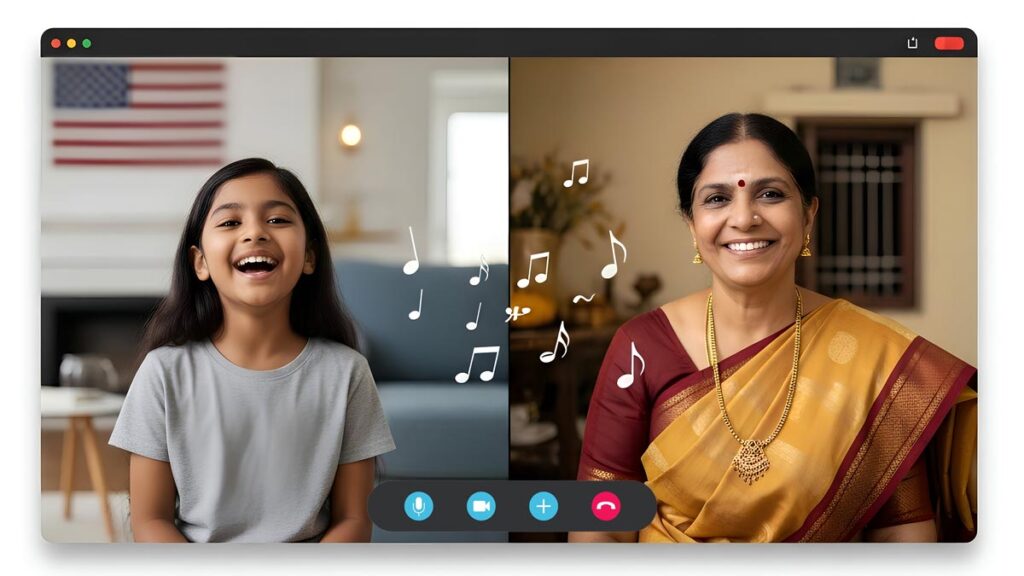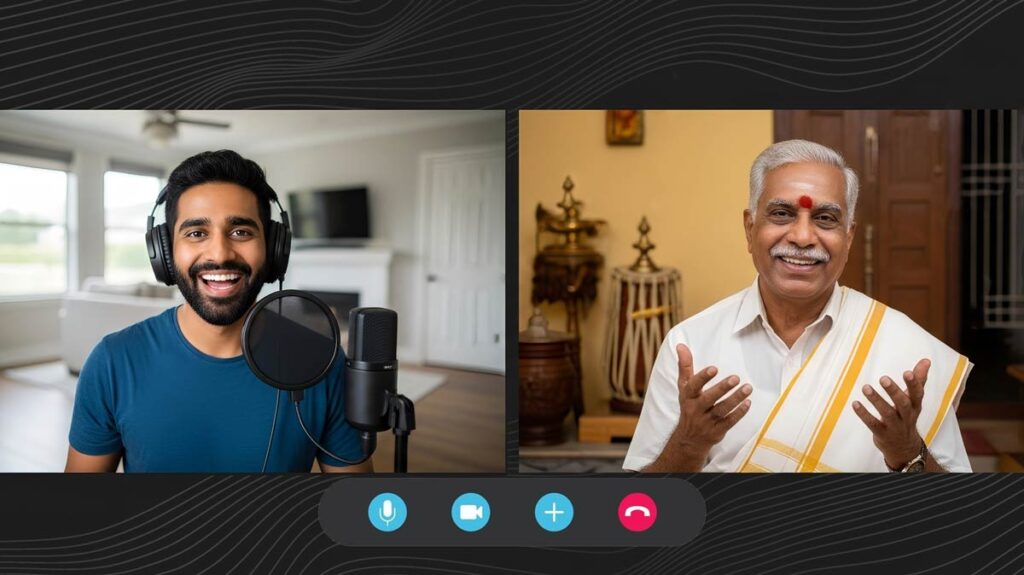![]()
Carnatic vs Hindustani Music: Complete Guide for Parents Choosing in 2025
Carnatic vs Hindustani music - which classical tradition is right for your child? Compare learning approaches, cultural benefits, and practical considerations to make the best choice for your family's musical journey.

Introduction
“Should my daughter learn Carnatic or Hindustani music?” This question kept Meera awake at night in her San Jose home. Her 8-year-old daughter Ananya had shown genuine interest in Indian classical music, but Meera felt overwhelmed by the choice. Her mother-in-law from Delhi insisted on Hindustani, while her Chennai-born neighbor swore by Carnatic music’s systematic approach.
If you’re torn between Carnatic vs Hindustani music for your child, you’re not alone. This is one of the most common dilemmas facing Indian-American parents who want to preserve their cultural heritage through music education.
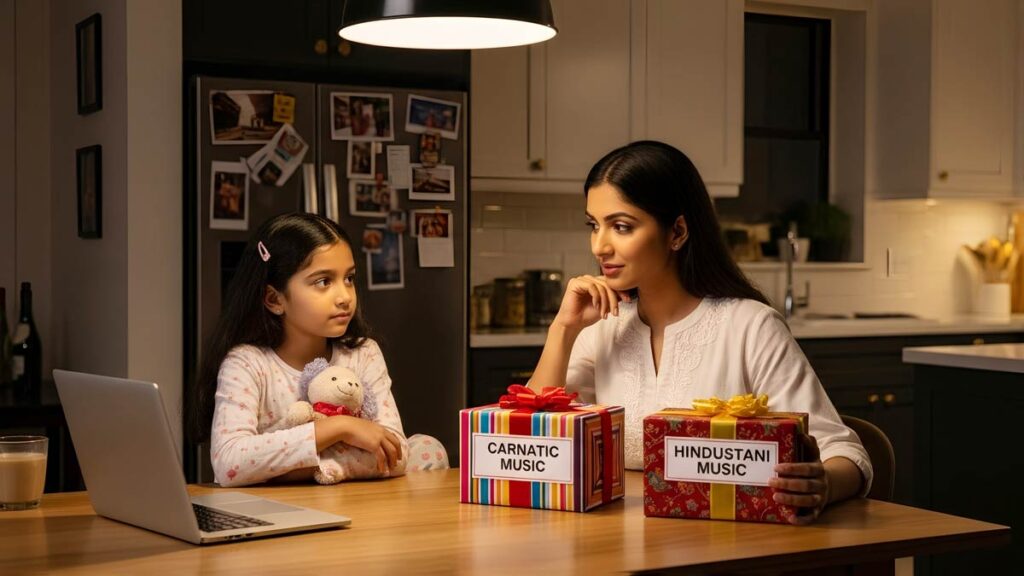
Both Carnatic and Hindustani music are magnificent classical traditions with rich histories, spiritual depth, and cognitive benefits. But they differ significantly in learning approach, cultural context, and practical considerations for families living in America.
This comprehensive guide will help you understand the key differences, evaluate what works best for your child’s personality and your family’s goals, and make a confident decision. Whether you’re in California’s tech corridors or New York’s suburbs, whether your family roots trace to Tamil Nadu or Punjab, this comparison will clarify which path aligns with your cultural and educational priorities.
By the end of this article, you’ll know exactly which tradition suits your child – and more importantly, why that choice will serve your family’s cultural journey for years to come.
Table of Contents
Understanding the Two Great Traditions
Carnatic Music: The Systematic Southern Approach
Carnatic music, predominantly from South India, is known for its highly structured, systematic approach to learning and its deep spiritual foundation rooted in devotion and philosophy.
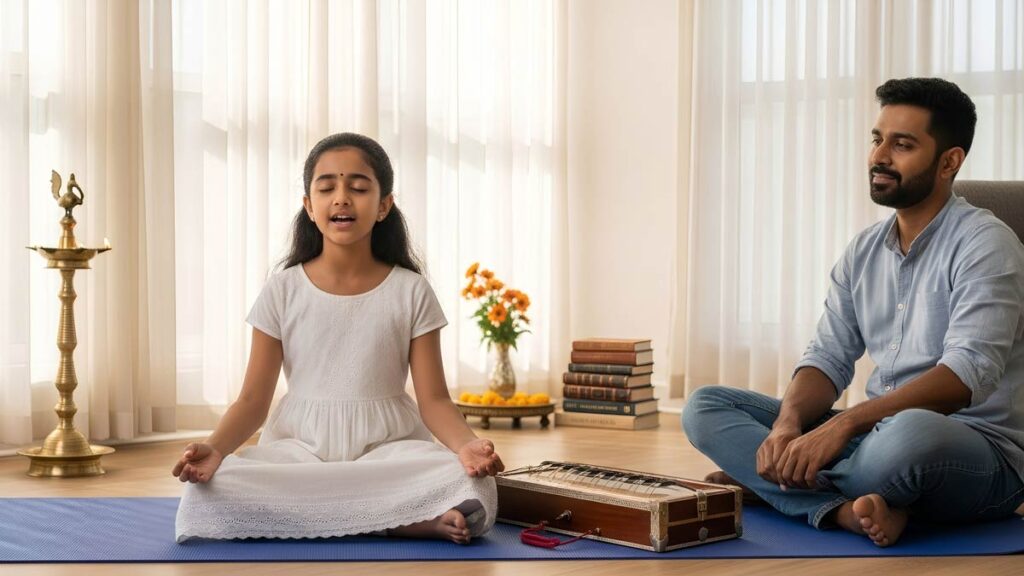
Key Characteristics of Carnatic Music:
🎵 Highly Structured Learning Path
Students follow a systematic progression: basic exercises (sarali varisai), scales (melakarta ragas), simple compositions (geetams), structured pieces (varnams), and finally complex compositions (kritis).
🎵 Mathematical Precision
Rhythm (tala) systems are mathematically precise, making it excellent for children who enjoy patterns and logical thinking.
🎵 Devotional Foundation
Most compositions are devotional, connecting students to spiritual themes and philosophical concepts from Hindu tradition.
🎵 Improvisation Within Structure
While highly systematic, Carnatic music encourages creativity through alapana (raga elaboration) and kalpana swaras (improvised passages).
🎵 Written Notation System
Uses a clear notation system that helps students understand and remember compositions accurately.
Hindustani Music: The Expressive Northern Tradition
Hindustani music, from North India, emphasizes emotional expression, improvisation, and the gradual unfolding of ragas through elaborate exploration.
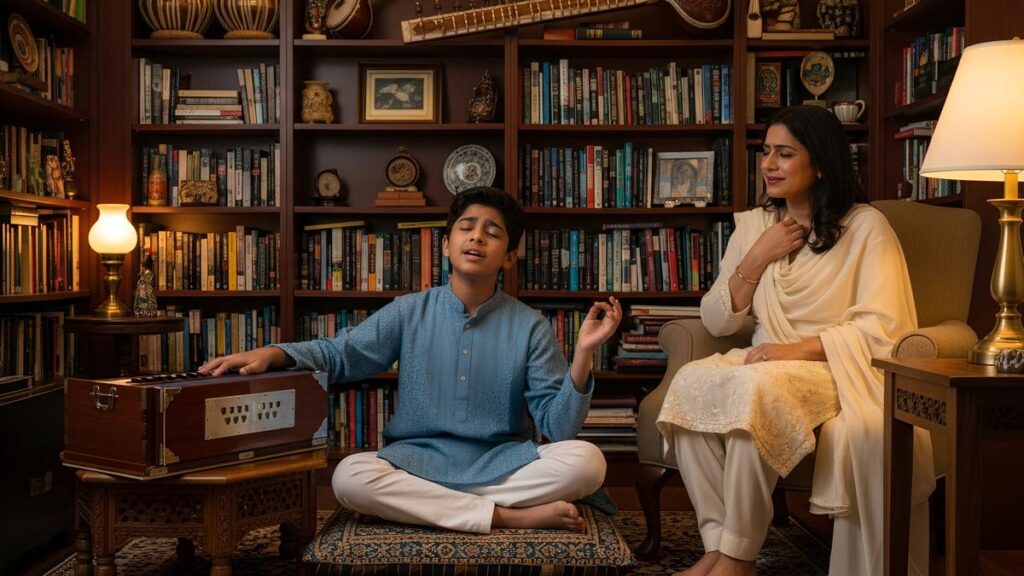
Key Characteristics of Hindustani Music:
🎵 Emphasis on Emotional Expression
Prioritizes the emotional and expressive aspects of music, encouraging students to convey deep feelings through their singing.
🎵 Extensive Improvisation
Heavy focus on improvisation, particularly in alap (slow, unmetered exploration of raga) and taan (fast melodic passages).
🎵 Gradual Raga Development
Ragas are explored slowly and extensively, with emphasis on mood creation and emotional journey.
🎵 Diverse Cultural Influences
Incorporates influences from Persian, Arabic, and Central Asian musical traditions, creating a rich cultural tapestry.
🎵 Oral Tradition Emphasis
Traditionally passed down orally from guru to student, emphasizing the personal relationship and intuitive learning.
Cultural and Regional Connections
| Aspect | Carnatic Music | Hindustani Music |
|---|---|---|
| Geographic Origin | South India (Tamil Nadu, Karnataka, Andhra Pradesh, Kerala) | North India (Punjab, Uttar Pradesh, Rajasthan, Gujarat) |
| Language Base | Primarily Sanskrit, Tamil, Telugu, Kannada | Hindi, Urdu, Persian, with some Sanskrit |
| Cultural Context | Hindu temple traditions, classical literature | Mughal courts, Sufi traditions, folk influences |
| Learning Approach | Systematic, structured progression | Intuitive, emotion-based development |
| Performance Style | Seated, meditative, devotional | More varied, can be elaborate and theatrical |
| Notation Usage | Extensive use of written notation | Traditionally oral, notation less emphasized |
Learning Approach Comparison: What Works for Your Child
Carnatic Music Learning Journey
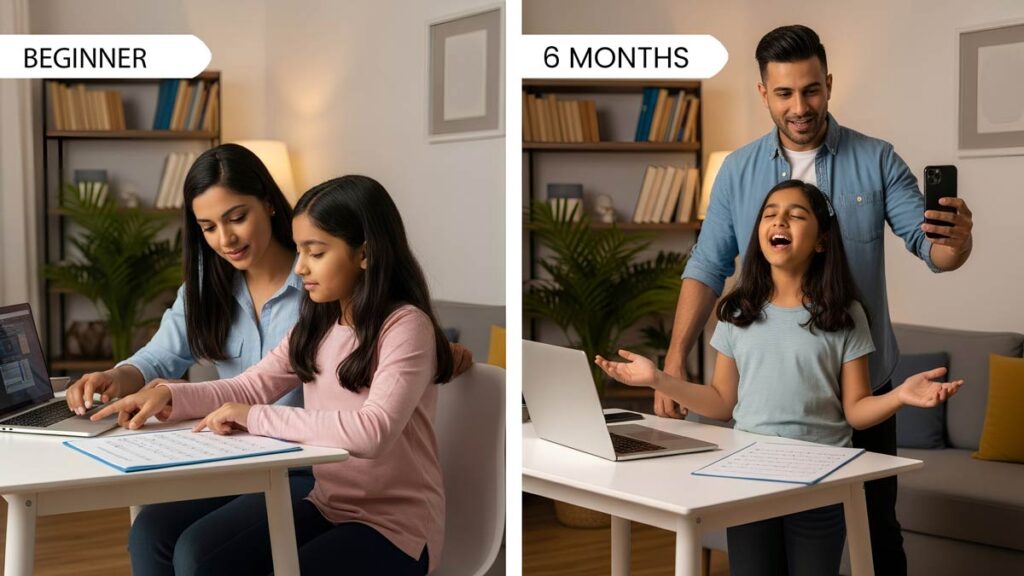
Months 1-6: Foundation Building
- Sarali Varisai: Basic scale exercises that build pitch accuracy
- Janta Varisai: Pattern exercises that develop rhythm sense
- Alankarams: Decorative exercises that introduce raga concepts
- Simple Geetams: First compositions that combine melody and rhythm
Why This Works for Many Children:
✅ Clear Progress Markers: Children can see exactly what they’ve accomplished
✅ Builds Confidence: Each level mastered creates sense of achievement
✅ Develops Discipline: Regular practice of exercises builds good habits
✅ Mathematical Appeal: Logical progression appeals to analytical minds
Months 6-18: Skill Development
- Swarajatis: More complex rhythmic compositions
- Varnams: Structured pieces that are the backbone of Carnatic music
- Simple Kritis: Devotional compositions by great composers
- Basic Raga Understanding: Learning the emotional and technical aspects of ragas
Year 2+: Advanced Learning
- Complex Kritis: Masterpieces by Tyagaraja, Dikshitar, and Syama Sastri
- Alapana: Improvised raga exploration
- Neraval: Improvisation on composition lines
- Kalpana Swaras: Advanced improvisation techniques
Hindustani Music Learning Journey
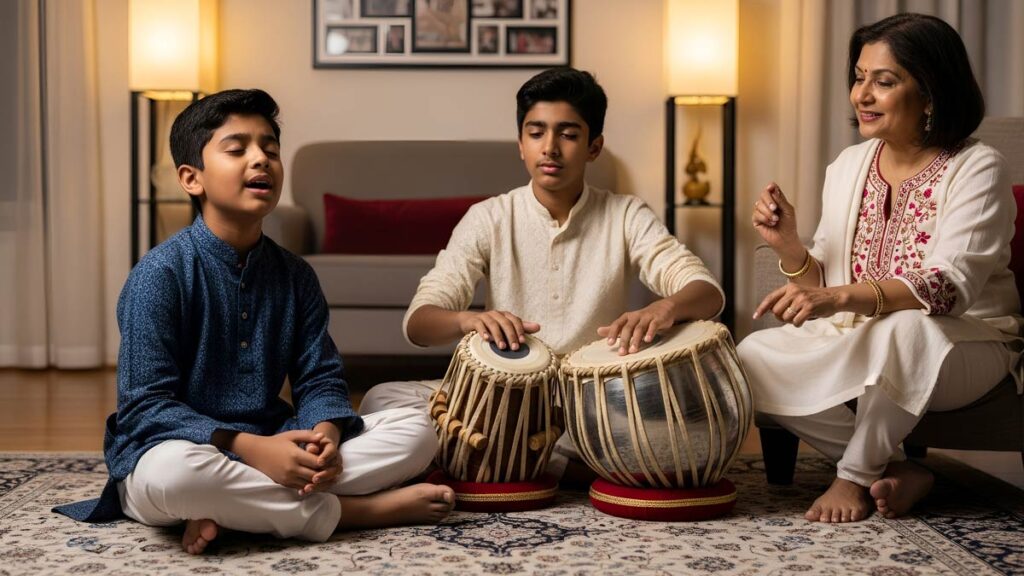
Months 1-6: Emotional Foundation
- Alankars: Basic exercises, but with emphasis on emotional expression
- Simple Ragas: Learning 2-3 basic ragas with focus on mood and feeling
- Bhajans/Ghazals: Devotional or emotional songs that connect to the heart
- Breathing and Voice Development: Emphasis on vocal expression and control
Why This Appeals to Certain Children:
✅ Emotional Connection: Children who are naturally expressive thrive
✅ Creative Freedom: More room for personal interpretation early on
✅ Cultural Storytelling: Songs often tell stories that engage imagination
✅ Family Bonding: Oral tradition encourages family participation
Months 6-18: Raga Exploration
- Detailed Raga Study: Deep exploration of 5-7 ragas with extensive improvisation
- Bandish Learning: Traditional compositions in various ragas
- Alap Practice: Slow, meditative raga exploration without rhythm
- Taan Development: Fast melodic passages that showcase skill
Year 2+: Mastery Development
- Advanced Ragas: Complex ragas with subtle nuances
- Extensive Improvisation: Long alap and elaborate taan work
- Classical Compositions: Learning from various gharanas (schools)
- Performance Skills: Developing stage presence and audience connection
Which Learning Style Suits Your Child?
Choose Carnatic Music If Your Child:
🎯 Enjoys Structure and Clear Goals: Thrives with step-by-step progression and measurable achievements
🎯 Has Analytical Thinking: Enjoys patterns, mathematics, and logical sequences
🎯 Likes Detailed Learning: Prefers thorough understanding before moving to next level
🎯 Responds to Devotional Content: Connects with spiritual themes and philosophical concepts
🎯 Benefits from Written Support: Learns better with notation and visual aids
🎯 Prefers Consistent Practice: Does well with regular, systematic practice routines
Choose Hindustani Music If Your Child:
🎯 Is Naturally Expressive: Shows strong emotional responses to music and art
🎯 Enjoys Creative Freedom: Prefers exploration over rigid structure
🎯 Learns Through Feeling: Intuitive learner who grasps concepts through experience
🎯 Loves Storytelling: Engages with narrative and emotional content in songs
🎯 Thrives in Oral Tradition: Learns better through listening and imitation
🎯 Enjoys Improvisation: Shows interest in creating and experimenting with music
Cultural and Family Considerations
Regional Heritage and Family Connections
Your Family’s Cultural Background Matters:
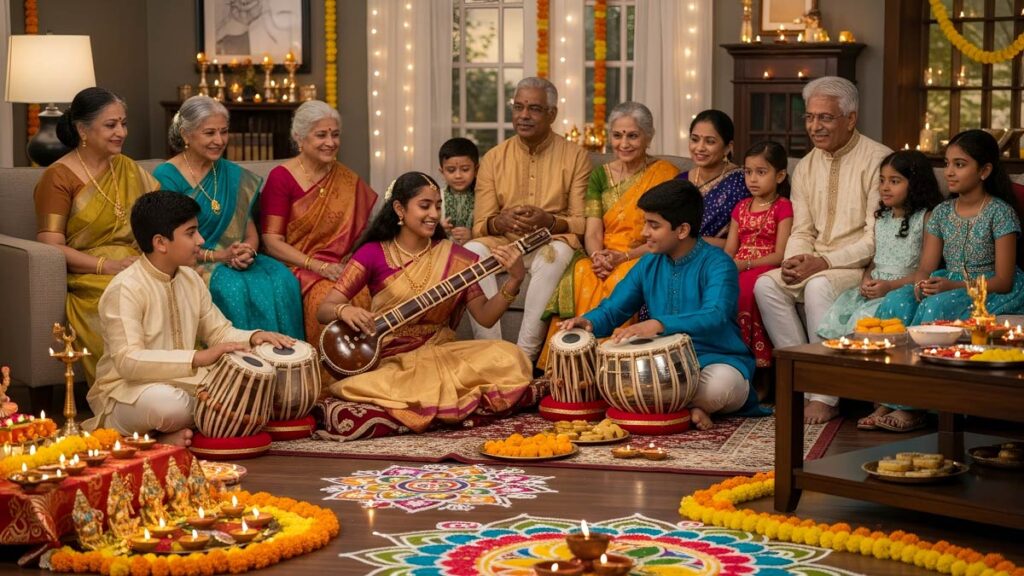
South Indian Heritage Families:
If your family roots trace to Tamil Nadu, Karnataka, Andhra Pradesh, or Kerala:
✅ Cultural Authenticity: Carnatic music connects directly to your ancestral traditions
✅ Language Connection: Sanskrit and regional language lyrics feel familiar
✅ Festival Integration: Fits naturally into South Indian cultural celebrations
✅ Extended Family Appreciation: Grandparents and relatives immediately recognize and value the learning
✅ Community Connection: Strong Carnatic music communities in most US cities with South Indian populations
North Indian Heritage Families:
If your family background is from Punjab, Uttar Pradesh, Rajasthan, Gujarat, or other North Indian states:
✅ Cultural Resonance: Hindustani music reflects your family’s musical heritage
✅ Language Familiarity: Hindi and Urdu lyrics connect to family language background
✅ Celebration Integration: Perfect for North Indian festivals and family gatherings
✅ Generational Bonding: Grandparents can share their own musical memories and knowledge
✅ Community Participation: Fits into North Indian cultural associations and events
Mixed Heritage or Pan-Indian Families:
Many Indian-American families have diverse regional backgrounds or want to embrace broader Indian culture:
Consider These Factors:
- Child’s Natural Inclination: Let their learning style guide the choice
- Local Community: Which tradition has stronger representation in your area?
- Teacher Availability: Which style has better qualified teachers accessible to you?
- Long-term Goals: What kind of cultural connection do you want to build?
Practical Considerations for American Families
| Practical Factor | Carnatic Music | Hindustani Music |
|---|---|---|
| Learning Resources | Extensive notation, structured books | More audio/video based, fewer written materials |
| Practice Requirements | Regular, systematic daily practice | Flexible practice, emphasis on listening |
| Performance Opportunities | Temple events, cultural associations | Cultural programs, family gatherings |
| Teacher Availability | Strong in South Indian communities | Available in North Indian communities |
| Instrument Needs | Tanpura, basic percussion | Harmonium, tabla (for accompaniment) |
| Time to Basic Proficiency | 12-18 months for simple performances | 18-24 months for basic improvisation |
Language and Spiritual Considerations
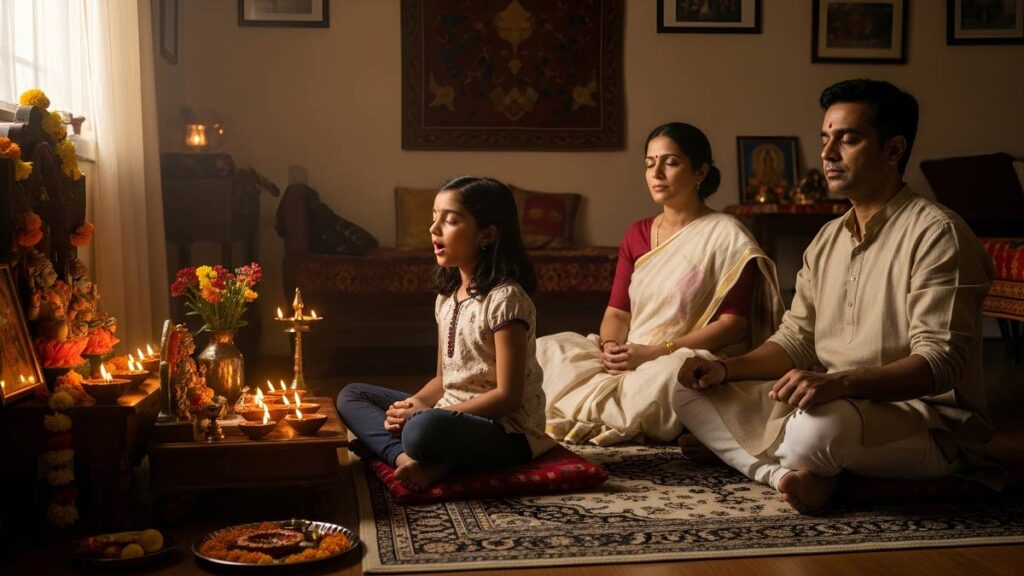
Carnatic Music Language Elements:
- Sanskrit Compositions: Connect to Hindu philosophical traditions and spiritual concepts
- Regional Languages: Tamil, Telugu, Kannada compositions provide linguistic diversity
- Devotional Themes: Most songs praise deities and explore spiritual concepts
- Cultural Education: Learning includes understanding of composers, historical context, and religious significance
Hindustani Music Language Elements:
- Hindi/Urdu Lyrics: More accessible to families comfortable with these languages
- Persian Influences: Rich poetic traditions and Sufi spiritual elements
- Diverse Themes: Devotional, romantic, seasonal, and philosophical content
- Cultural Breadth: Exposure to various cultural influences and historical periods
Building Cultural Identity in America
How Each Tradition Helps Your Child:
Carnatic Music for Cultural Identity:
🌟 Deep Roots: Provides strong connection to ancient Indian traditions and philosophy
🌟 Discipline and Focus: Builds character traits valued in both Indian and American contexts
🌟 Academic Benefits: Mathematical precision supports STEM learning
🌟 Spiritual Grounding: Offers meditative and spiritual practices for life balance
🌟 Community Integration: Connects to temple communities and cultural organizations
Hindustani Music for Cultural Identity:
🌟 Emotional Intelligence: Develops deep emotional expression and empathy
🌟 Creative Confidence: Builds improvisational skills that transfer to other areas
🌟 Cultural Appreciation: Exposes to diverse Indian cultural influences
🌟 Artistic Sensitivity: Develops aesthetic appreciation and artistic judgment
🌟 Social Connection: Creates bonds through shared emotional musical experiences
Practical Decision-Making Framework
Assessment Questions for Your Family
Before choosing between Carnatic vs Hindustani music, honestly evaluate:
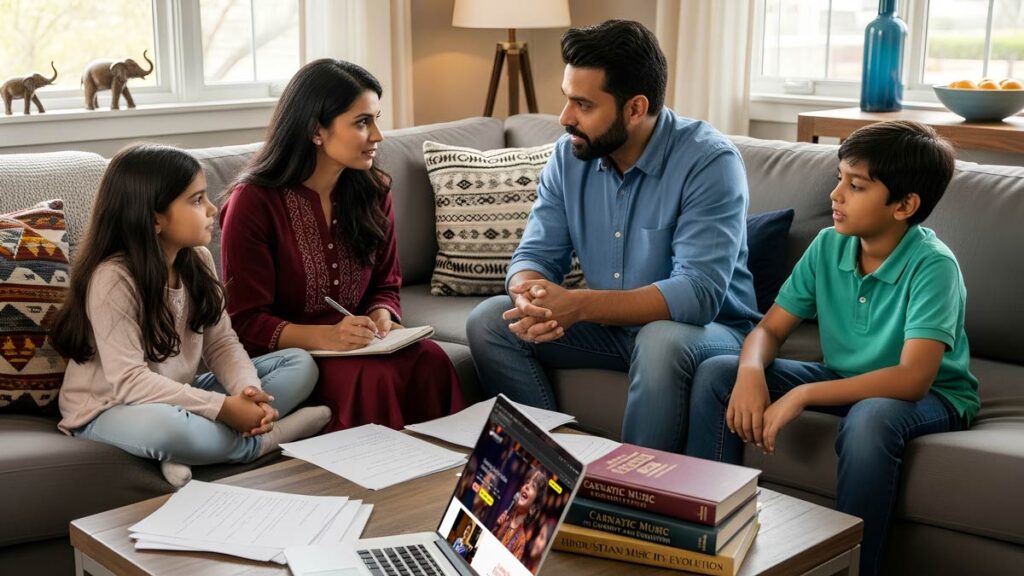
Child-Centered Questions:
🤔 Learning Style Assessment:
- Does your child prefer step-by-step instructions or learning through exploration?
- Do they enjoy structured activities or creative, open-ended play?
- Are they more analytical or intuitive in their approach to new skills?
- Do they like to understand “why” before doing, or learn by doing first?
🤔 Personality and Interests:
- Is your child naturally expressive with emotions, or more reserved?
- Do they enjoy performing for others or prefer private practice?
- Are they drawn to spiritual/devotional content or secular themes?
- Do they like detailed, precise work or broad, creative expression?
🤔 Practical Considerations:
- How much time can your family realistically dedicate to practice?
- Does your child respond better to daily short sessions or longer weekly sessions?
- Are they motivated by clear goals and achievements or by personal satisfaction?
- How important is quick visible progress versus deep, gradual development?
Family-Centered Questions:
🤔 Cultural Goals:
- What aspects of Indian culture are most important for your family to preserve?
- Do you want to connect to specific regional traditions or broader Indian heritage?
- How important is it that grandparents and extended family understand and appreciate the music?
- Do you want the music to integrate with your family’s spiritual practices?
🤔 Practical Support:
- Which tradition do you feel more equipped to support at home?
- Are there community resources (temples, cultural centers) that support one tradition more?
- Do you have family members who can provide additional guidance in either tradition?
- Which style fits better with your family’s lifestyle and schedule?
Trial and Exploration Strategy
Smart families don’t guess – they test both options:
The Two-Month Exploration Approach:
Month 1: Carnatic Music Trial
- Enroll in a trial program or take 4-6 lessons
- Observe your child’s response to structured learning
- Note their comfort with notation and systematic progression
- Assess family’s ability to support regular practice routine
Month 2: Hindustani Music Trial
- Try a different approach with emphasis on expression and improvisation
- Observe your child’s response to creative freedom and emotional content
- Note their engagement with oral learning and intuitive development
- Assess family’s comfort with less structured, more flexible approach
Evaluation Criteria:
✅ Child’s Enthusiasm: Which approach generates more genuine excitement?
✅ Natural Aptitude: Where does your child show more natural ability?
✅ Family Harmony: Which tradition creates less stress and more joy at home?
✅ Progress Indicators: Where do you see more meaningful development?
✅ Cultural Connection: Which tradition helps your child connect more deeply to their heritage?
Making the Final Decision
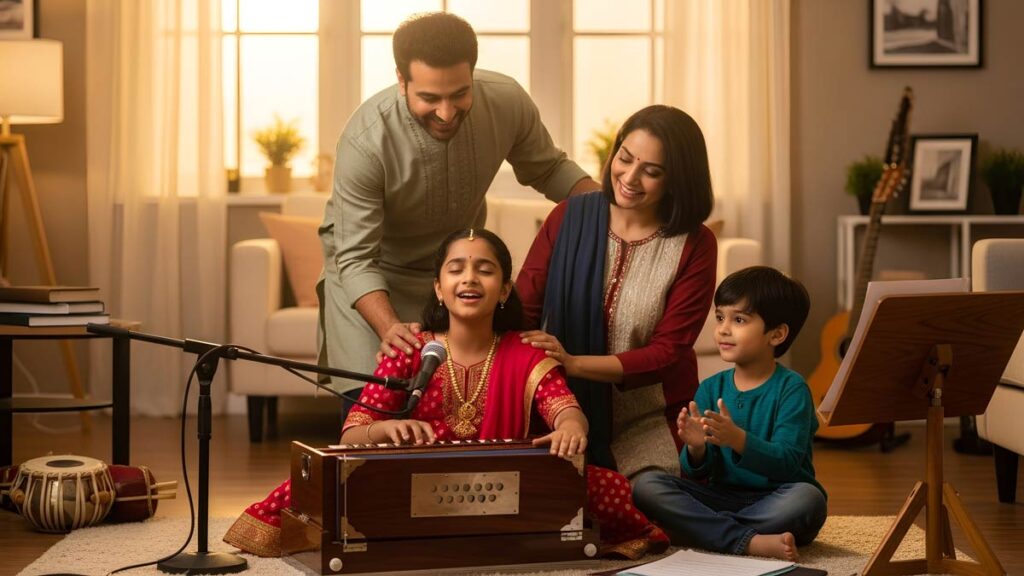
Remember: There’s No Wrong Choice
Both Carnatic and Hindustani music offer:
- Deep cultural connection and heritage preservation
- Cognitive benefits and academic advantages
- Spiritual and emotional development
- Community building and family bonding
- Lifelong appreciation for Indian classical arts
The right choice is the one that:
✅ Matches your child’s learning style and personality
✅ Aligns with your family’s cultural goals and background
✅ Fits practically with your lifestyle and resources
✅ Generates genuine enthusiasm from your child
✅ Creates positive family experiences around music
Trust your instincts, involve your child in the decision, and remember that starting with one tradition doesn’t prevent exploring the other later in their musical journey.
Swaramrit’s Approach to Musical Tradition
Why We Specialize in Carnatic Music
At Swaramrit Music Academy, we’ve chosen to focus exclusively on Carnatic music, and here’s why this benefits families making the Carnatic vs Hindustani music decision:
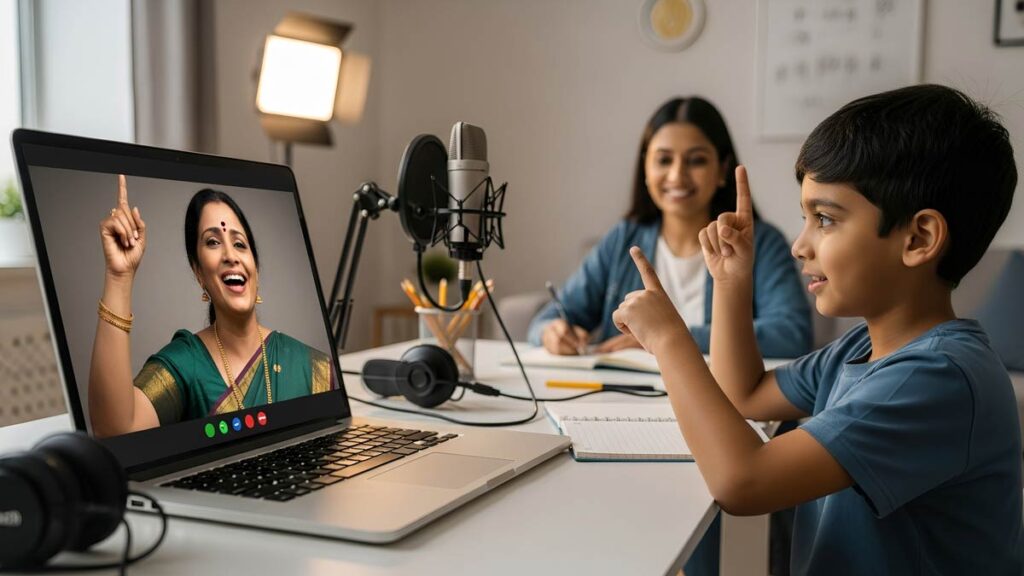
Deep Expertise in One Tradition:
Rather than offering both styles superficially, we provide authentic, comprehensive Carnatic music education with:
✅ Master Teacher Leadership: M. Rajappa’s decades of experience in traditional Carnatic pedagogy
✅ Systematic Curriculum: Proven progression that builds strong foundations before advancing
✅ Cultural Authenticity: Deep understanding of spiritual and philosophical contexts
✅ Regional Expertise: Authentic South Indian musical traditions and pronunciation
✅ Specialized Teaching Methods: Techniques specifically developed for Carnatic music learning
Why This Helps Your Decision:
When you choose Swaramrit, you’re choosing:
- Clarity: No confusion about mixed approaches or diluted teaching
- Depth: Complete immersion in one rich tradition rather than surface-level exposure to both
- Expertise: Teachers who live and breathe Carnatic music, not generalists
- Results: Proven outcomes from focused, specialized instruction
Supporting Families Who Choose Carnatic Music
Our “Learning through Encouragement” philosophy particularly suits Carnatic music because:
🎵 Systematic Progress Recognition: We celebrate each milestone in the structured Carnatic learning path
🎵 Cultural Context Integration: Every lesson includes the spiritual and cultural significance of what students learn
🎵 Family Involvement: We help parents understand and support the systematic practice requirements
🎵 Individual Pacing: While maintaining structural integrity, we adapt to each child’s learning speed
🎵 Modern Application: We show how ancient Carnatic principles apply to contemporary life and values
What Swaramrit Families Experience
Comprehensive Carnatic Music Education:
✅ Traditional Foundation: Authentic learning progression from basic exercises to complex compositions
✅ Cultural Immersion: Understanding of composers, historical context, and spiritual significance
✅ Modern Convenience: Online learning that fits American family schedules and lifestyles
✅ Family Support: Guidance for parents in supporting systematic practice and cultural appreciation
✅ Community Connection: Virtual events and recitals that build cultural community
✅ Long-term Development: Clear pathways for advancing from beginner to accomplished musician
For families who choose Carnatic music after reading this comparison, Swaramrit provides the authentic, comprehensive education that honors this magnificent tradition while serving modern family needs.
Frequently Asked Questions About Choosing
Can my child learn both Carnatic and Hindustani music?
While theoretically possible, most music educators recommend mastering one tradition first before exploring the other. The learning approaches are quite different, and mixing them early can create confusion.
Better Approach:
Ages 6-12: Focus on one tradition to build strong foundation
Ages 13+: Consider exploring the second tradition as enrichment
Adult learners: Can more easily appreciate and learn both simultaneously
At Swaramrit: We recommend dedicating at least 2-3 years to Carnatic music before considering Hindustani exploration, ensuring your child has a solid foundation in one tradition.
Which tradition is easier for children to learn?
Neither is inherently “easier” – they’re different:
Carnatic Music Advantages:
Clear structure makes progress measurable
Written notation supports learning
Systematic approach suits many children’s learning styles
Hindustani Music Advantages:
Emotional expression can be more immediately satisfying
Less rigid structure may feel less pressured
Oral tradition can be engaging for auditory learners
The “easier” choice depends entirely on your child’s learning style and personality.
Which tradition offers better career opportunities?
Both traditions offer similar opportunities in terms of:
Teaching: Qualified instructors are needed for both styles
Performance: Cultural events and concerts feature both traditions
Music Therapy: Both styles are used in therapeutic applications
Cultural Leadership: Both traditions value knowledgeable practitioners
Career considerations should not be the primary factor – cultural connection and personal fulfillment matter more for long-term success.
What if we choose wrong and want to switch?
There’s no “wrong” choice, and switching is always possible:
If You Start with Carnatic:
The systematic foundation often makes learning Hindustani easier later
Notation skills transfer to other musical learning
Disciplined practice habits benefit any musical pursuit
If You Start with Hindustani:
Emotional expression and improvisation skills are valuable in any tradition
Ear training and intuitive learning transfer well
Creative confidence benefits all musical endeavors
At Swaramrit: We’ve had families who tried other approaches and found their home in Carnatic music. We welcome students at any stage of their musical journey.
How do I know if my child is making the right progress?
Progress indicators differ between traditions:
Carnatic Music Progress Signs:
Accurate pitch in basic exercises within 2-3 months
Comfortable with simple compositions by 6 months
Beginning raga recognition by 8-10 months
Confident performance of kritis by 12-15 months
Hindustani Music Progress Signs:
Emotional connection to ragas within 3-4 months
Basic improvisation attempts by 6-8 months
Comfortable alap singing by 10-12 months
Personal style development by 15-18 months
Most importantly: Your child should show genuine enthusiasm and cultural connection regardless of which tradition they’re learning.
Conclusion: Making the Right Choice for Your Family
The decision between Carnatic vs Hindustani music isn’t about choosing the “better” tradition – both are magnificent classical systems with profound cultural value. It’s about choosing the approach that best serves your child’s learning style, your family’s cultural goals, and your practical circumstances.
Key Decision Factors to Remember:
🎯 Child’s Learning Style: Systematic learners often thrive with Carnatic; expressive learners may prefer Hindustani
🎯 Family Heritage: Your regional background can guide cultural authenticity
🎯 Practical Resources: Consider teacher availability and community support in your area
🎯 Long-term Goals: Think about how music will integrate into your family’s cultural life
🎯 Trial Experience: Let your child experience both approaches before deciding
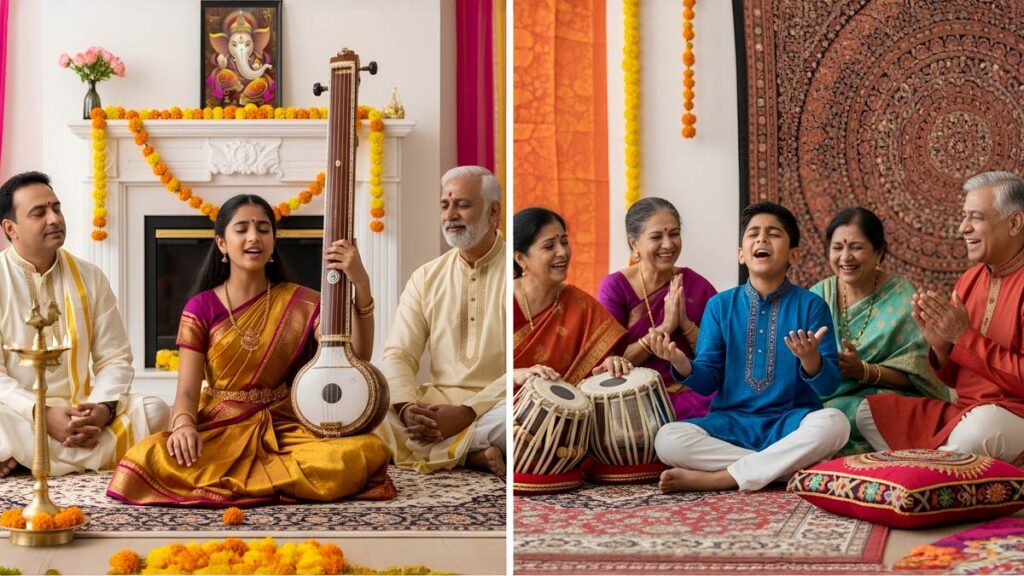
Whatever you choose, you’re giving your child:
- Deep connection to Indian cultural heritage
- Cognitive and academic benefits from classical music training
- Spiritual and emotional development through traditional arts
- Community connections and cultural identity strengthening
- Skills and appreciation that will enrich their entire lifetime
For families who resonate with Carnatic music’s systematic approach, spiritual depth, and structured learning,
provide authentic, comprehensive education led by experienced teachers who understand both the tradition and the needs of modern American families.
The most important thing is to begin. Whether you choose the systematic beauty of Carnatic music or the expressive richness of Hindustani music, you’re opening a door to cultural treasure that will benefit your child and family for generations.
Ready to explore Carnatic music for your family?
for a consultation about how our systematic, encouraging approach to Carnatic music education can serve your child’s cultural and musical development.
Continue Your Musical Education Research:
Finding Your Musical Community in America
Where Each Tradition Thrives in the US:
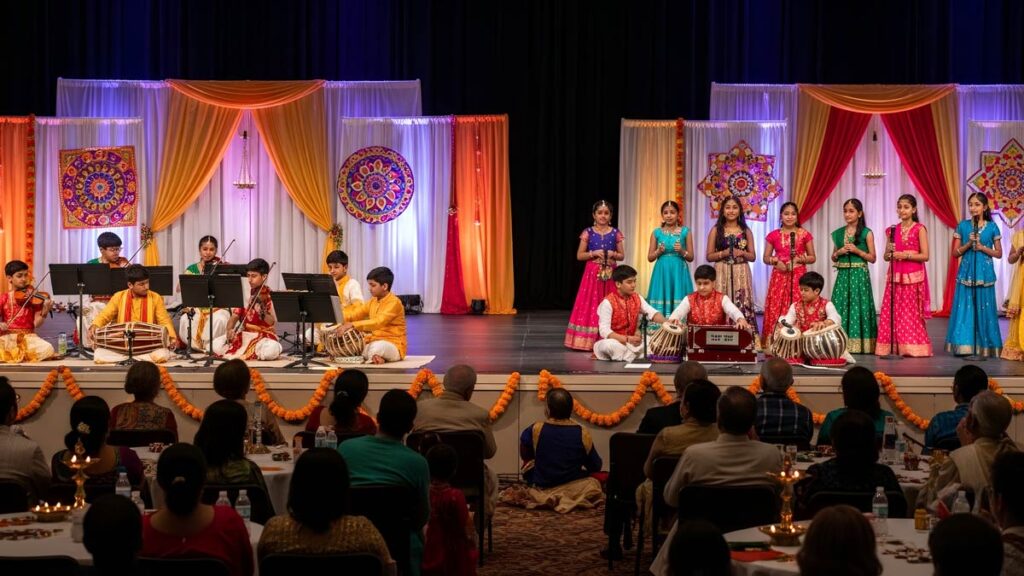
| US Region | Carnatic Music Community | Hindustani Music Community |
|---|---|---|
| San Francisco Bay Area | Strong South Indian temples and cultural associations | Growing North Indian community centers |
| New York/New Jersey | Established communities in Edison, Jersey City | Large Punjabi and Hindi-speaking populations |
| Texas (Dallas/Houston) | Active South Indian cultural organizations | Diverse North Indian community groups |
| Chicago/Illinois | Well-established South Indian temples | Strong Gujarati and Hindi communities |
| Seattle/Washington | Tech community South Indian presence | Emerging North Indian cultural groups |
| Los Angeles/Southern California | Large Tamil and Telugu communities | Bollywood and North Indian cultural influence |
Age-Specific Recommendations Section:
Choosing Based on Your Child’s Age and Development
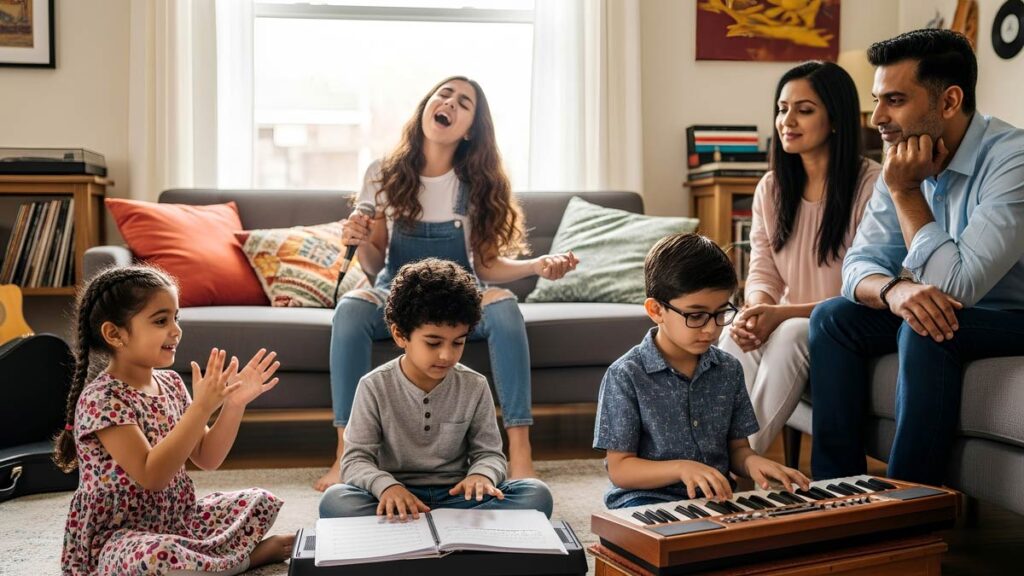
Age-Based Decision Framework:
Ages 4-7: Early Foundation Years
Carnatic Music Advantages:
- Simple, repetitive exercises build muscle memory
- Clear structure provides security for young learners
- Devotional content introduces cultural values early
- Notation helps with early literacy development
Hindustani Music Advantages:
- Emotional expression comes naturally to young children
- Story-based songs engage imagination
- Less pressure for technical precision
- Oral tradition feels like natural play
Recommendation: Try both approaches and see which generates more genuine enthusiasm.
Ages 8-12: Skill Development Years
Carnatic Music Advantages:
- Systematic progression matches school-age learning patterns
- Mathematical concepts align with academic development
- Clear achievement markers build confidence
- Discipline training supports overall academic success
Hindustani Music Advantages:
- Emotional intelligence development during crucial years
- Creative expression supports artistic development
- Improvisation builds problem-solving skills
- Cultural storytelling enriches historical understanding
Recommendation: This is the ideal age to commit to one tradition for deep foundation building.
Ages 13+: Advanced Development
Carnatic Music Advantages:
- Philosophical content resonates with developing abstract thinking
- Advanced mathematical concepts challenge intellectual growth
- Spiritual themes support identity development
- Performance opportunities build leadership skills
Hindustani Music Advantages:
- Emotional depth matches adolescent development
- Improvisation supports creative identity formation
- Cultural exploration aids in heritage understanding
- Expressive performance builds confidence
Recommendation: Teenagers can handle more complex decision-making and should be primary voices in the choice.
Teacher Quality Assessment Section:
Evaluating Teachers in Both Traditions
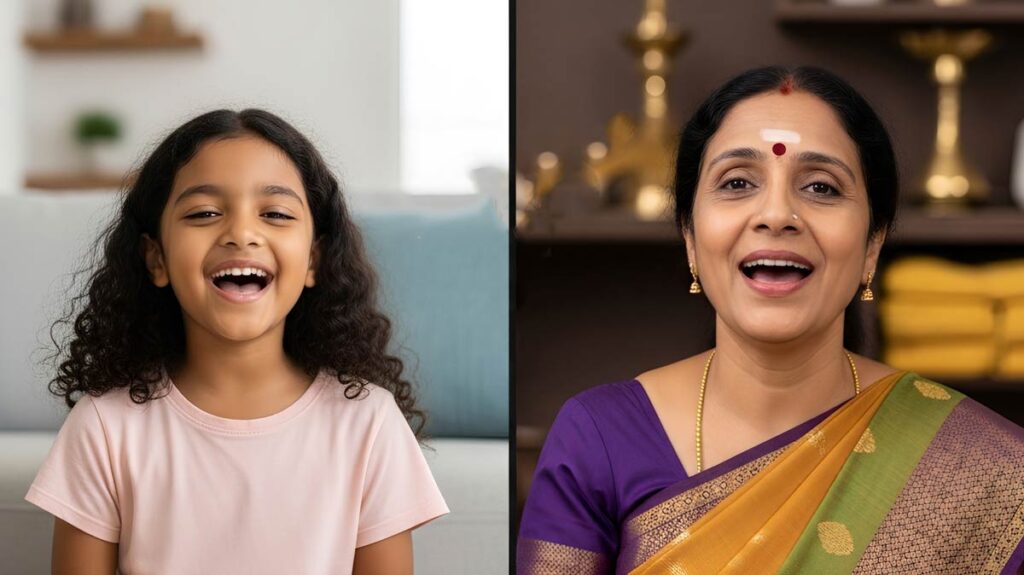
What to Look for in Carnatic Music Teachers:
✅ Systematic Teaching Approach: Can explain clear progression from basics to advanced
✅ Notation Expertise: Comfortable with written music and can teach reading skills
✅ Cultural Knowledge: Understands spiritual and philosophical contexts of compositions
✅ Patience with Structure: Doesn’t rush students through foundational exercises
✅ Regional Authenticity: Proper pronunciation and traditional knowledge
What to Look for in Hindustani Music Teachers:
✅ Emotional Connection: Can demonstrate and inspire expressive singing
✅ Improvisation Skills: Comfortable with spontaneous musical creation
✅ Oral Tradition Mastery: Excellent listening skills and memory
✅ Cultural Breadth: Knowledge of various gharanas and regional styles
✅ Intuitive Teaching: Can adapt to student’s natural learning patterns
Long-term Musical Journey Section:
Where Each Path Leads: 5-Year Outlook
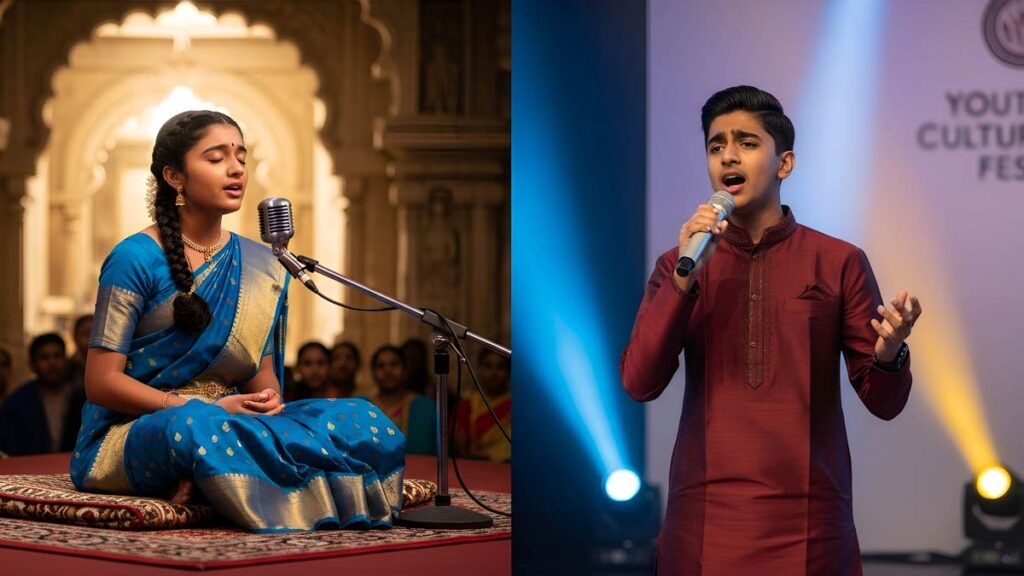
Carnatic Music 5-Year Journey:
- Year 1: Foundation exercises and simple compositions
- Year 2: Basic ragas and structured varnams
- Year 3: Complex kritis and beginning improvisation
- Year 4: Advanced compositions and cultural performances
- Year 5: Teaching capability and spiritual connection
Hindustani Music 5-Year Journey:
- Year 1: Basic ragas and emotional connection
- Year 2: Improvisation development and bandish learning
- Year 3: Advanced raga exploration and performance skills
- Year 4: Gharana-specific training and artistic development
- Year 5: Personal style development and cultural leadership
The Beautiful Convergence: What Both Paths Achieve
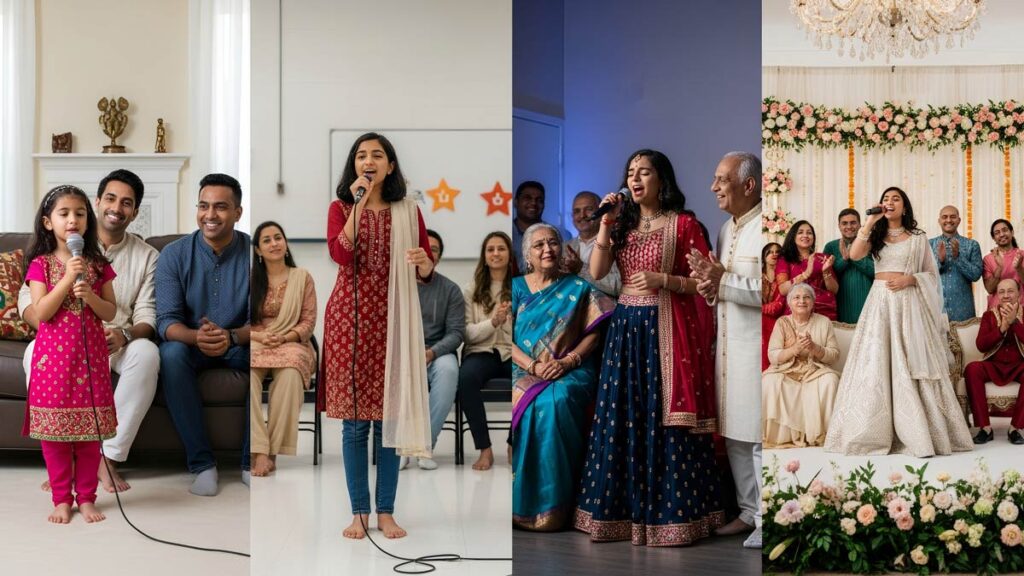
Regardless of which tradition you choose, after five years of dedicated learning, your child will have developed:
🎵 Deep Cultural Roots
Both Carnatic and Hindustani music create lasting connections to Indian heritage. Your teenager won’t just know songs – they’ll understand the philosophy, history, and spiritual significance behind the music. This cultural grounding becomes a source of strength and identity throughout their life.
🎵 Transferable Life Skills
The discipline, focus, and dedication required for either classical tradition builds character that extends far beyond music. Whether through Carnatic’s systematic approach or Hindustani’s expressive development, your child develops patience, perseverance, and the ability to pursue long-term goals.
🎵 Family Cultural Leadership
By age 16-17, accomplished students in either tradition often become cultural ambassadors for their families. They perform at weddings, lead cultural celebrations, and help preserve traditions for younger siblings and cousins. This leadership role builds confidence and cultural pride.
🎵 Community Connection and Service
Advanced students frequently become involved in teaching younger children, participating in cultural organizations, and contributing to their Indian-American community’s cultural life. This service orientation develops empathy and social responsibility.
🎵 Academic and Career Advantages
The cognitive benefits of classical music training – enhanced mathematical thinking, improved memory, better emotional regulation – support academic success and career development. Many of our advanced students credit their musical training with helping them excel in STEM fields, medicine, and other demanding professions.
The Lifelong Gift You’re Giving
When you choose between Carnatic vs Hindustani music, you’re not just selecting lessons – you’re choosing a cultural inheritance that will enrich your child’s entire life. Whether they become professional musicians or simply carry the music in their hearts, this decision shapes their relationship with their heritage, their family, and themselves.
The most successful musical journeys begin with families who:
- Choose based on their child’s authentic interests and learning style
- Commit to supporting the long-term learning process
- Integrate music into family cultural life and celebrations
- Celebrate progress and maintain enthusiasm through challenges
- View music education as cultural investment, not just skill development
Both traditions lead to the same beautiful destination: a culturally grounded, confident young adult who carries the treasures of Indian classical music into their American future, ready to share this gift with the next generation.

